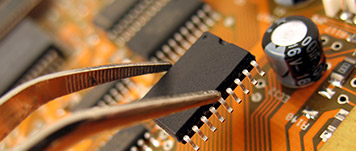- +64 9 269 6916
- +64 9 269 6926
For quick, professional and Friendly PCB manufacturing and PCB assembly you can rely on, talk to QualiEco Circuits
Technical Articles
Technical Articles
Introduction to PCB
Printed Circuit Boards (PCBs) are made from fibre glass material, commonly known as copper clad laminate, with copper tracks in place of wires. Copper tracks are chemically etched i.e. printed, which connect different components on the PCB. Through hole components are fixed in position by drilling holes and then soldering them on other side of the PCB.
Refer following chart to understand various types of PCBs that are in common use these days:

Rigid PCBs
The substrate used to manufacture PCB is purely rigid in nature and therefore it is called rigid PCBs. Rigid PCBs are mainly divided into 3 categories – Single layer (or single sided), Double layer (or double sided) and Multi-layer PCBs.
Single Layer/Sided PCB
The most basic PCBs have the components mounted on one side of the board and the conductor pattern on the other side.
Because there is only a conductor pattern on one side, this type of PCB is called 'single-sided’ or ‘single–layer’.
This type of circuit board is suitable for simple circuits only. Because there is only one side, no wires can cross and they have to be routed around each other.
Double Layer/Sided PCB
Double-sided or double-layer printed circuit boards (PCB)s are better suited to complex circuits as they have twice the area for the conductor pattern compared to single-sided PCBs.
Double-sided PCBs have a conductor pattern on both sides of the board. Having two separate conductor patterns requires an electrical connection between them.
Such electrical 'bridges' are called 'vias '. A via is simply a hole in the PCB that is filled or plated with metal and touches the conductor pattern on both sides.
Multi-Layer PCB
Multilayer PCBs have one or more conductor pattern inside the board, to increase the area available for the wiring. This is achieved by gluing (laminating) several double-sided circuit boards together with insulating layers in between.
The number of layers is referred to as the number of separate conductor patterns – usually even and including the two outer layers. Most boards have between 4 and 10 layers, but PCBs with almost 100 layers can be made.
Metal core PCBs
Advanced electronics demands efficient dissipation of heat away from the components. Thermally conductive dielectric material like Aluminium or copper alloy can help achieve this more effectively than standard FR-4 material.
The major advantages of metal core PCBs are heat dissipation, thermal expansion and dimensional stability.
Pure Flexible and Rigid-Flexi PCBs
Flexible Printed Circuits (FPC) are made with a photolithographic technology. A Flex Circuit or Flex PCB is a patterned arrangement of printed circuitry and components that utilizes flexible based material with or without flexible coverlay.
Flexible circuits offer the same advantages of a printed circuit board: repeatability, reliability, and high density but with the added “twist” of flexibility and vibration resistance. The most important attribute compelling designers to adopt flex circuit technology is the capability of the flex circuit to assume three-dimensional configurations.
Rigid-Flexible circuit boards are combination of rigid and flexible PCBs. The Rigid circuits (FR-4 PCB) are connected with single or multiple flex through PTH (via), inside or outside of Flex circuit layer, so it enjoys the advantage of both Rigid PCB and Flex circuit.
PCB Design Tips
When designing a PCB, try to limit the amount of draws you use. Draws use a lot of memory and slow the programming time. Use a flash for pads instead.
More tips...
Contract Assembly
We are one-stop solution provider for all your contract assembly requirements. We have the capability and resources to provide PCB assemblies, as well as cable and harness assemblies.
What our customers say?
QualiEco Circuits Limited is an excellent supplier to us! We appreciate the quality of service and support that we receive from QualiEco Circuits. They always deliver what is promised
For printed circuit boards (PCBs) or PCB assembly you can count on. Talk to the friendly and experienced team at QualiEco Circuits, New Zealand.


